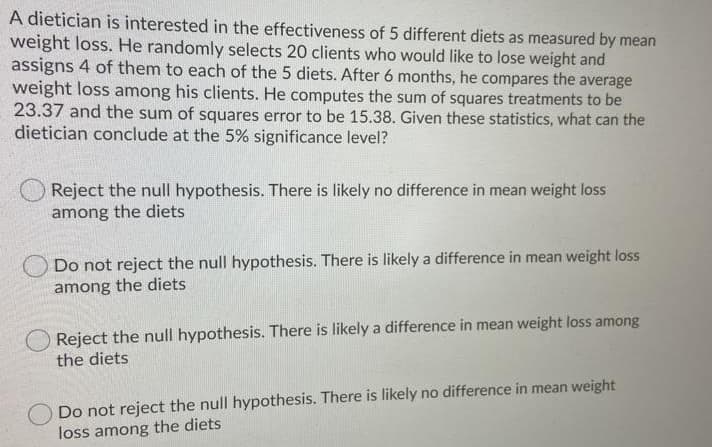A dietician is interested in the effectiveness of 5 different diets as measured by mean weight loss. He randomly selects 20 clients who would like to lose weight and assigns 4 of them to each of the 5 diets. After 6 months, he compares the average weight loss among his clients. He computes the sum of squares treatments to be 23.37 and the sum of squares error to be 15.38. Given these statistics, what can the dietician conclude at the 5% significance level? Reject the null hypothesis. There is likely no difference in mean weight loss among the diets Do not reject the null hypothesis. There is likely a difference in mean weight loss among the diets Reject the null hypothesis. There is likely a difference in mean weight loss among the diets Do not reject the null hypothesis. There is likely no difference in mean weight Joss among the diets
A dietician is interested in the effectiveness of 5 different diets as measured by mean weight loss. He randomly selects 20 clients who would like to lose weight and assigns 4 of them to each of the 5 diets. After 6 months, he compares the average weight loss among his clients. He computes the sum of squares treatments to be 23.37 and the sum of squares error to be 15.38. Given these statistics, what can the dietician conclude at the 5% significance level? Reject the null hypothesis. There is likely no difference in mean weight loss among the diets Do not reject the null hypothesis. There is likely a difference in mean weight loss among the diets Reject the null hypothesis. There is likely a difference in mean weight loss among the diets Do not reject the null hypothesis. There is likely no difference in mean weight Joss among the diets
Linear Algebra: A Modern Introduction
4th Edition
ISBN:9781285463247
Author:David Poole
Publisher:David Poole
Chapter7: Distance And Approximation
Section7.3: Least Squares Approximation
Problem 31EQ
Related questions
Question
42

Transcribed Image Text:A dietician is interested in the effectiveness of 5 different diets as measured by mean
weight loss. He randomly selects 20 clients who would like to lose weight and
assigns 4 of them to each of the 5 diets. After 6 months, he compares the average
weight loss among his clients. He computes the sum of squares treatments to be
23.37 and the sum of squares error to be 15.38. Given these statistics, what can the
dietician conclude at the 5% significance level?
Reject the null hypothesis. There is likely no difference in mean weight loss
among the diets
Do not reject the null hypothesis. There is likely a difference in mean weight loss
among the diets
Reject the null hypothesis. There is likely a difference in mean weight loss among
the diets
Do not reject the null hypothesis. There is likely no difference in mean weight
loss among the diets
Expert Solution
This question has been solved!
Explore an expertly crafted, step-by-step solution for a thorough understanding of key concepts.
Step by step
Solved in 2 steps with 1 images

Recommended textbooks for you

Linear Algebra: A Modern Introduction
Algebra
ISBN:
9781285463247
Author:
David Poole
Publisher:
Cengage Learning

Linear Algebra: A Modern Introduction
Algebra
ISBN:
9781285463247
Author:
David Poole
Publisher:
Cengage Learning